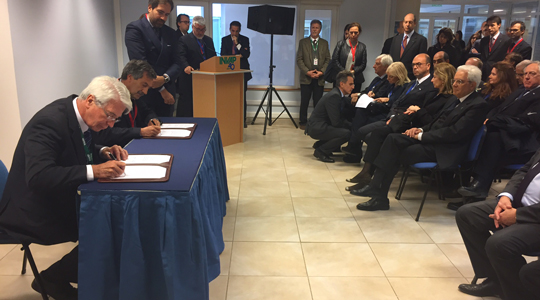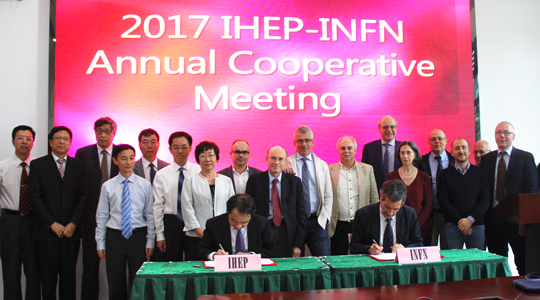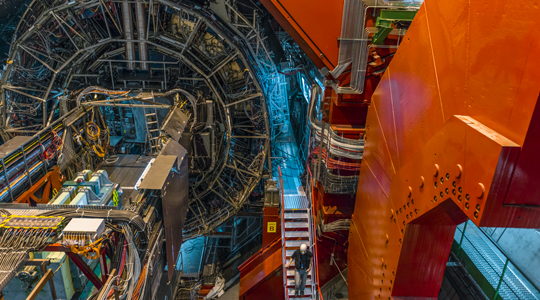THE INFN AT THE ITALY-AUSTRALIA FORUM OF SCIENCES AND INNOVATION
 On 15 May 2017, the first Italo-Australian science and innovation forum was held, organised by the Italian Embassy and the Australian Department of Industry, Innovation and Science. The event was attended by about a hundred Italian and Australian researchers from INFN, represented by the Vice President Antonio Masiero, from EGO, represented by the Director Federico Ferrini, and from ASI, INAF, ENEA, CNAO and OGS. Many were the topics addressed, from the detection of dark matter to gravitational waves and space technologies; much interest has also been placed in hadron therapy for the treatment of cancer and marine sciences.
On 15 May 2017, the first Italo-Australian science and innovation forum was held, organised by the Italian Embassy and the Australian Department of Industry, Innovation and Science. The event was attended by about a hundred Italian and Australian researchers from INFN, represented by the Vice President Antonio Masiero, from EGO, represented by the Director Federico Ferrini, and from ASI, INAF, ENEA, CNAO and OGS. Many were the topics addressed, from the detection of dark matter to gravitational waves and space technologies; much interest has also been placed in hadron therapy for the treatment of cancer and marine sciences.
Italy is today the eighth scientific partner of Australia and there are 190 bilateral agreements in place between universities and research institutes of the two countries which have enabled a significant increase in the number of joint scientific publications over the past 10 years, currently standing at 8,000. The future projects discussed include Ska, ET, the development of an Australian research programme on gravitational waves, part of a global infrastructure project with LIGO-Virgo in the northern hemisphere and the launch of an underground laboratory (the first in the southern hemisphere) in close cooperation with the Gran Sasso laboratory.
Thanks to this forum, it was possible to complete the bilateral agreement for cooperation in science
and technology between Australia and Italy signed a few days later, on May 22nd, by the Italian
Ambassador in Canberra, Pier Francesco Zazo, and the Australian Minister for Industry, Innovation
and Science, Arthur Sinodinos





 The European XFEL, the future European free electron super-microscope, successfully completed one of the last stages of its construction: the first beam of electrons was accelerated along the entire length of the machine, of 2.1 km. The first superconducting linear accelerator in the world of this size has hence started functioning: this is a crucial step for the commencement of the scientific activities, scheduled for next Autumn, when in the laboratories of the European XFEL in Hamburg, Germany, it will be possible to photograph and film, with atomic resolution, the biological, chemical and matter processes, both in the condensed and in the excited state of plasma. The European XFEL is, in fact, a project for the creation of a fourth generation synchrotron radiation source, based on the FEL (Free Electron Laser) process. That’s the result of a scientific collaboration, led by DESY (Deutsches Elektronen-Synchrotron) and in which Italy, with INFN, is one of the leading international partners. The accelerator that is now operative will feed the X-ray laser and is therefore the key-component system, for a total length of 3.4 km, of what will be the free electron super-microscope. INFN has made an
The European XFEL, the future European free electron super-microscope, successfully completed one of the last stages of its construction: the first beam of electrons was accelerated along the entire length of the machine, of 2.1 km. The first superconducting linear accelerator in the world of this size has hence started functioning: this is a crucial step for the commencement of the scientific activities, scheduled for next Autumn, when in the laboratories of the European XFEL in Hamburg, Germany, it will be possible to photograph and film, with atomic resolution, the biological, chemical and matter processes, both in the condensed and in the excited state of plasma. The European XFEL is, in fact, a project for the creation of a fourth generation synchrotron radiation source, based on the FEL (Free Electron Laser) process. That’s the result of a scientific collaboration, led by DESY (Deutsches Elektronen-Synchrotron) and in which Italy, with INFN, is one of the leading international partners. The accelerator that is now operative will feed the X-ray laser and is therefore the key-component system, for a total length of 3.4 km, of what will be the free electron super-microscope. INFN has made an  The cooperation between Italy and China for dark matter research is confirmed and strengthened. During the bilateral meeting of May 9thbetween INFN and IHEP (Institute for High Energy Physics) of Beijing, the two Institutes signed the letter of interest to participate in the HERD (High Energy Cosmic Radiation Detection) experiment.HERD is one of the main science projects of the Chinese Space Station, which involves the construction of a new powerful space telescope. The scientific objectives of HERD, whose launch is planned for 2020, are dark matter particle detection, cosmic ray composition analysis and high energy gamma ray observation. The main characteristics of the future detector are its total weight, which will be less than 2 tons, and its total energy consumption, which will be less than 2 kilowatts.
The cooperation between Italy and China for dark matter research is confirmed and strengthened. During the bilateral meeting of May 9thbetween INFN and IHEP (Institute for High Energy Physics) of Beijing, the two Institutes signed the letter of interest to participate in the HERD (High Energy Cosmic Radiation Detection) experiment.HERD is one of the main science projects of the Chinese Space Station, which involves the construction of a new powerful space telescope. The scientific objectives of HERD, whose launch is planned for 2020, are dark matter particle detection, cosmic ray composition analysis and high energy gamma ray observation. The main characteristics of the future detector are its total weight, which will be less than 2 tons, and its total energy consumption, which will be less than 2 kilowatts.  The ALICE experiment at the Large hadron collider (LHC) at CERN has observed for the first time in collisions between protons an increase in the production of so-called strange particles, which is one of the distinguishing phenomena of quark-gluon plasma, a very hot and dense state of matter which existed just a few millionths of a second after the Big Bang. So far, this characteristic of the state of primordial matter had only been observed in collisions between heavy nuclei, and nobody thought that it could also be found in proton collisions. This unexpected observation is a challenge to existing theoretical models, which do not include the increase of strange particles in these events. The result, published in Nature Physics on April 24
The ALICE experiment at the Large hadron collider (LHC) at CERN has observed for the first time in collisions between protons an increase in the production of so-called strange particles, which is one of the distinguishing phenomena of quark-gluon plasma, a very hot and dense state of matter which existed just a few millionths of a second after the Big Bang. So far, this characteristic of the state of primordial matter had only been observed in collisions between heavy nuclei, and nobody thought that it could also be found in proton collisions. This unexpected observation is a challenge to existing theoretical models, which do not include the increase of strange particles in these events. The result, published in Nature Physics on April 24

